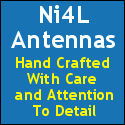Posts Tagged ‘Antenna projects’
 In the park with 5 watts, KX3 and new Endfed antenna
In the park with 5 watts, KX3 and new Endfed antenna
| My outdoor shack |
| Golfball setup |
10m Frequency SWR
28.020 3.8
28.060 3.8
15m
21.020 2.9
21.060 2.9
20m
14.020 3.8
14.060 3.8
40m
7.020 8.4
7.040 8.4
The antenna was mounted in a sloper configuration the high end at about 20 feet off the ground and the other end ground mounted. The tuner in the KX3 was able to bring all bands but 40m to a flat match, I was able to get 40m down to 1.5. The bands were very quite but I did spend some time
| Anchor point |
 In the park with 5 watts, KX3 and new Endfed antenna
In the park with 5 watts, KX3 and new Endfed antenna
| My outdoor shack |
| Golfball setup |
10m Frequency SWR
28.020 3.8
28.060 3.8
15m
21.020 2.9
21.060 2.9
20m
14.020 3.8
14.060 3.8
40m
7.020 8.4
7.040 8.4
The antenna was mounted in a sloper configuration the high end at about 20 feet off the ground and the other end ground mounted. The tuner in the KX3 was able to bring all bands but 40m to a flat match, I was able to get 40m down to 1.5. The bands were very quite but I did spend some time
| Anchor point |
 If at first you don’t succeed try try again!
If at first you don’t succeed try try again!
Well, here we are once again trying to get the portable ham radio setup going.
My first attempt was to place one of my mono band whips on my bike and set out a counter poise. It was with mixed results, the SWR was sometimes all over, there was a TX error message now and again on my KX3 and basically frustration trying to get it to work. So if at first you don’t succeed try try again.
Last week I was online searching again for another way to get my portable op’s on the air. I was looking for something that was easy to deploy, was portable and worked!
My interest has gone toward the Endfed antennas. I was looking at LNR’s antennas and then I came across the Endfed 40-6m antenna by Steve W1SFR. I shot him some questions regarding the antenna and he got back to me right away with the answers. His Endfed seems to be very well built using Wireman “silky” 18 gauge wire which I have used in the past and been very happy with. There was a nice noticeable quality in both the wire connections and the 9:1 unUn.
The antenna is only 35 feet but you do need about 25 feet of coax to act as a counter poise. Also your rig needs to have an antenna tuner (mine does) to get the benefit of 6m-40m with only a 35′ antenna and no traps. Also it was nice to see on his web site a link to purchase his antenna including shipping to VE3 land.
The shipping was super reasonable the total came to 67.00 U.S. Steve also mentions that his price includes handling as well. Other sites I had gone to being very interested in their antenna to only find out the shipping at times was either 1/2 or more of the price of the antenna.
There was lots of positive reviews on Eham about Steve’s antenna as well. I put some items I am not using in the shack sold them very fast and the funds were in place so I have placed my order and waiting for it to arrive.
I have the 25′ of coax on hand but I do have to head out to the hardware store for some rope 1/8″ nylon rope. Then I’m thinking of placing a water bottle with some sand it it as a weight to get the rope up and over a tree branch…..that is going to take some practice!
 A slight change of plans…..
A slight change of plans…..
| The test setup |
 A brief overview of my MFJ 1788 loop antenna.
A brief overview of my MFJ 1788 loop antenna.
| The antenna |
1. Very small foot print for an antenna that will give you 15m to 40m.
2. The antenna can be used mounted horizontally or vertically.
3. Once you get used to the tuning it's very fast and easy to tune.
4. I covered my antenna with as to keep it low profile and it works no problem with the cover.
5. The antenna remote control can operate either on AC or batteries.
6. Can be mounted on a simple tri-pod.
Some of the draw backs
1. The quality of the antenna is low, I had to make some adjustments to make it work as it should.
2. The band width is narrow and retuning has to be down often.
3. The SWR meter in the remote control unit is not very reliable.
4. Buzzer used to tell you the coarse tuning has finished is VERY hard to hear.
| Repairing Cap spacing |
On air results with this antenna have been good, with regards to receiving I have been able to hear the Middle East, South Pacific, Europe, South America and of coarse North America. Now hearing a station and contacting the station is another ball of wax. With my power restrictions I have made some very satisfying contacts. My modest signal has made it into South America, all parts of Europe, Iceland and Africa so far. There are two Loop antennas that MFJ makes and if I was to make the choice again I would had gone with the MFJ 1786 as it covers 10m to 30m. I have found with this antenna there is no way to tune it below 15m. The characteristic of the tuning capacitor will not allow it. I have read the MFJ 1788 is like a wet noodle on 40m and it's true I have not been able to make it into the U.S. The MFJ 1786 would had been a better choice with more band opportunities.
 SWR up’s and down’s
SWR up’s and down’s
| LP-100 reading |
| K3 meter |
 Final repairs on MFJ loop
Final repairs on MFJ loop
| Time to repair the control box. |
| Ready to remove switch |
| A great tool to have |











